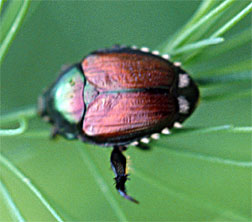 Susceptible Plants
Susceptible Plants
Roses (Rosa), crabapples (Malus), lindens (Tilia), willow (Salix), birch (Betula), cherry (Prunus), raspberry (Rubus), grape (Vitis), and many other ornamental trees, shrubs, and flowers.
Description & Symptoms
Japanese beetles are 3/8" long, slightly rounded, metallic green insects. The beetles can be easily seen feeding in large groups on leaf and flower tissue. Leaves and flowers become skeletonized. The white, C-shaped grubs of these beetles feed on the roots of turf grass, causing dead brown patches to appear.
Timing & Life Cycle
Adult beetles emerge in early July and feed for four to six weeks on more than 300 species of plants. Female beetles lay eggs in the soil 3 inches below the surface of a lawn. Grubs hatch two weeks later and feed on grass roots for about eight weeks until they are full-grown. Grubs burrow deeper into the soil to hibernate for the winter, coming to the surface the following May or June to feed on roots again. These grubs develop into the adult Japanese beetles that emerge in early July.
Damage
Adult beetles cause extensive damage to plant tissue. Skeletonized leaves and petals eventually will drop off. The damage, however, is largely aesthetic, and most plants do not die from these attacks.
When found in large numbers, beetle grubs cause serious lawn damage because they chew on grass roots. This damage usually is most severe from August to early fall. Grass browns and large sections often can be peeled back from the ground. Lawn damage sometimes is compounded by raccoons and skunks, who dig for grubs.
Treatment & Solutions
Hand-picking Japanese beetles from plants or knocking them into a bucket of soapy water is the best control. Beetles are attracted to plants where other beetles already are feeding, so clusters of beetles often are found together. Traps baited with floral and pheremone scents will catch beetles, but they also will attract them, bringing more beetles into a garden. Although insecticides will kill Japanese beetles, sprays must be applied repeatedly during the six-week feeding period. They also will kill many beneficial insects.
Lawns can withstand a grub population of up to 12 grubs per square foot before suffering any damage. At higher populations, chemical treatments are usually warranted. Grubs thrive in well-irrigated soil. Reducing lawn watering in summer may help lower numbers of grubs.
For more information about Japanese beetles, call the Plant Information hotline at (847) 835-0972.

